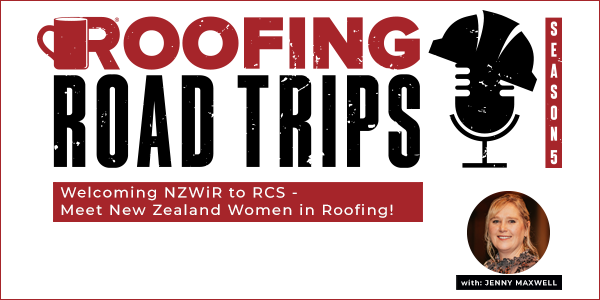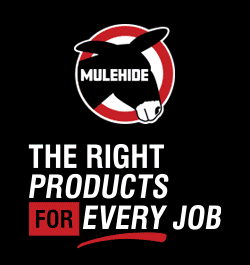JR Babineau - Get Code Compliant and Climate Ready - PODCAST TRANSCRIPT
June 17, 2025 at 11:00 a.m.Editor's note: The following is the transcript of a live interview with JR Babineau of Johns Manville. You can read the interview below or listen to the podcast.
Intro: Welcome to Roofing Road Trips, the podcast that takes you on a thrilling journey across the world of roofing. From fascinating interviews with roofing experts to on-the-road adventures, we'll uncover the stories, innovations and challenges that shape the rooftops over our heads, so fasten your seat belts and join us as we embark on this exciting Roofing Road Trip.
Megan Ellsworth: Hello everyone. Welcome back to Roofing Road Trips. My name is Megan Ellsworth here at rooferscoffeeshop.com. I'm really excited because we're talking about code compliance, being climate-ready with the experts at Johns Manville and I'm here with JR. Hello. How are you?
JR Babineau: Hi, Megan. I'm doing very well today. Thank you.
Megan Ellsworth: Yay. I'm really excited to hear what you have to say and hopefully learn something. I'm sure I will, so let's start out with, can you just introduce yourself and tell us a little bit about you and your role at JM?
JR Babineau: Sure. My name's JR Babineau. I'm the senior research manager for Building Sciences here at Johns Manville and in that role, I actually work under our corporate research and development group, so I support all of our divisions, including our roofing division, our insulation systems division, with really a focus on how buildings work, how do JM products work correctly in building systems, with the idea that ultimately we want successful projects. And I've been with JM now for 28 years.
Megan Ellsworth: Wow. Oh, my gosh. Congratulations.
JR Babineau: Thank you.
Megan Ellsworth: That's coming up on the big three-oh.
JR Babineau: Yes, that's right.
Megan Ellsworth: That's huge. That's really cool. I just think being with one company and seeing the growth and the continued education and just experimentation, that's something that's really cool, so congratulations.
JR Babineau: Awesome. Thank you. I would say that the things that you've talked about are a lot of why I'm still here after all this time.
Megan Ellsworth: For sure. Okay, so let's get into it. What is continuous insulation, CI and how does it differ from traditional cavity insulation?
JR Babineau: Sure. I mean, really, the name kind of says it. Continuous insulation is continuous. It's meant to cover all of the other structural elements that we would normally find in the building envelope, so versus traditional cavity insulation, again, it fits in between. So, especially in the United States or North America, we build a lot frame construction, so that gives these convenient cavities to insulate in, but that doesn't tell the whole story. So, continuous insulation is really there to give us that continuous coverage for good thermal control.
Megan Ellsworth: Okay. Okay. Makes total sense. When did the adoption of continuous insulation start? Just curious, when did that kind of become popular?
JR Babineau: Well, so I mean, it's been popular with concrete construction, for example, where there are no cavities, so we've had continuous insulation for decades or forever. Honestly, back in, when I say the turn of the century, the turn of the 20th century, continuous insulation was used when it was cork, so before our modern materials even existed. So, continuous insulation has always been around and really evolution of the energy codes has really pushed in the last, let's say, 20 to 30 years, more continuous insulation to be used for frame construction, especially commercial construction that is often done with steel frame. So, that's really what's driven a lot of that adoption.
JR Babineau: And certainly even more recently, that's the big push, right? Because what we're realizing is, is to get energy codes to be better, to get our buildings to be better, we're really running out of how good they can be if all we do is put more insulation in the cavities and leave the framing alone. We're really hitting that diminishing returns point there and so continuous insulation, that's one of the big levers left that we can pull to get our buildings to be better.
Megan Ellsworth: Yeah, absolutely and especially with the heat island effect right now that everyone's talking about, getting energy under control and in your control is so important. And so, you touched on energy codes. I know they're changing, so how has the adoption of continuous insulation changed local and national energy codes, you would say?
JR Babineau: Sure. I would say, I mean, it's kind of the other way around, right? It is the changing of the energy codes is what's really driven project teams to use continuous insulation more, because again, because that's the only way to get there. So the energy codes, whether it's prescriptively or through a performance approach, set these targets for buildings, depending on what the building is and then we've got to get there. So, those codes get adopted by jurisdictions and that becomes kind of law locally.
JR Babineau: And so for buildings to hit these new targets, as we continually tighten the screws and say, "Okay, these buildings need to use less and less energy," that's what's really driven the adoption of continuous insulation. To combine that with just trying to cost-effectively build buildings, continuous insulation is just what we need. If we're going to put up a building with steel studs and steel framing and all of that and especially somewhere like here in Denver where it's a cold climate, even though it's not cold today, we lose a lot of heat through all that steel framing. Continuous insulation really just has to be part of the equation to successfully get that building to function properly.
Megan Ellsworth: Yeah, absolutely. Okay, so going off of that, you've mentioned steel. What are some of the common materials used with continuous insulation and roofing and wall systems?
JR Babineau: Sure. Yup, yup. So, I would say interestingly, it's largely the same materials, whether it's for a roof or a wall. I would say roofing, from a continuous insulation perspective, is really, honestly, ahead of the game, because especially for commercial buildings, most of the time we're insulating that above the deck with continuous insulation anyway and have been for decades. It's really walls that are playing catch-up.
JR Babineau: So for roofs, most often it's polyisocyanurate foam is what's most commonly used for continuous insulation on commercial roofs. Of course, there are other materials too. There are polystyrene foams that get used sometimes, there's polyurethane foams, so a lot of different types of foam plastics and also products like mineral wool. There are mineral wool boards that also get used on commercial roofs and all of those same materials, you see those on walls as well. Because again, they do a good job and oftentimes bring other functions as well, other than just thermal. They can deliver other benefits when we put them on walls. So, we kind of see both materials in both places, though oftentimes what drives those choices can vary, depending on the project.
Megan Ellsworth: Right, yeah and the area.
JR Babineau: Absolutely. Yes.
Megan Ellsworth: Absolutely. Okay, so can you talk a little bit about moisture management and CI's role in air barrier performance and moisture management?
JR Babineau: Sure, absolutely. Right. I would say CI plays a big role or can play a big role in both of these, especially I would say today, in walls, we see that more and more. So one of the things, first, CI materials just help to reduce any sort of condensation risk that we might see inside the building envelope, which is important, especially in a cold climate, though also in warm climates. Just because when we wrap our building in continuous insulation, everything that's inside of that is literally inside now. It sees less temperature variation, it sees less loads from moisture, wind, all of those things.
JR Babineau: The other thing that CI materials can do, at least some of them, where a lot of the foam plastics can do double or triple duty, oftentimes if we wrap our building in a foam plastic, that means not only is it a good insulator, it can stop airflow. And depending on the material and how the seams are detailed and things like that, it can also keep out the water. So, CI can play an enormous role and honestly, that can go a long way to help make those decisions easier from a cost and performance perspective.
Megan Ellsworth: Yeah and I was just talking to someone the other day about mold prevention. It's so important, so important and you don't want those spores coming into the house or the building. And so, yeah, using products like CI to really mitigate that moisture and then also creating that air barrier is so important.
Yeah, yeah, it really is. And you know, one of the things that CI really can provide, let's say as an air barrier for example, if we think about the envelope of a building, sometimes it can be very complicated and where to air seal that building, what joints and connections to get a really successful air barrier, can be very challenging. And honestly, that's one of the things that CI provides is usually a cleaner plane that we can see.
JR Babineau: If you think about all the connections that would go into framing and window and door and all of those different connections and materials that come together in a building and we're going to try to air seal all that, it can be done, it gets done all the time. But if then we instead wrap that whole thing in some foam boards, well, now we probably have less seams to deal with, less edges, less joints. And now if we seal all that up, well, we get a very effective air barrier without as much pain and suffering, basically, for the guys in the field that have to actually build it.
Megan Ellsworth: Yeah and the less pain and suffering, the better.
JR Babineau: Absolutely. Always.
Megan Ellsworth: Absolutely. Okay, so how should contractors approach selecting the right CI product mixed for specific climate zone or building type?
JR Babineau: Sure. How do they go about that?
JR Babineau: I mean, that's a good question. I guess from my perspective, ultimately, there should be a design professional who's made that choice.
Megan Ellsworth: Got it.
JR Babineau: So, at that high level, if we're between polyiso versus polyisocyanurate versus mineral wool versus spray foam, if you kind of step back and there's all of these different product types, really, whether that's the architect or a building envelope consultant, somebody should have made that bigger choice ahead of time. Because it really depends, like you said, depends on the climate zone. It depends on just what is the strategy for the given building to manage heat, air and moisture and also fire, frankly, too, especially in a commercial building. How do we manage all of those things? And that will drive the choices.
JR Babineau: So for example, let's say we're building in, I don't know, Seattle and so we've got a very wet but kind of temperate climate and we need to manage a lot of moisture load, we need to allow for a lot of drying, there the strategy may very well be, well, we're going to do a drained rain screen sort of approach and we're going to use mineral wool on the outside because it drains and dries very easily. And so, there's a lot that goes into that design.
JR Babineau: And so the contractor coming in later shouldn't really be able to go and say, "Well, I'd like to use, I don't know, polystyrene instead," right? That would drastically change the design and function of that system. And so, those sorts of substitutions, it kind of makes me cringe a little bit, because then we don't know if all of the consequences have been thought through of making that change, versus if, let's say, polystyrene was part of the design to begin with. Well, I mean, the contractor certainly has freedom to then say, "Well, am I going to buy it from manufacturer A or manufacturer B or C," when they're really pretty equivalent products, that's kind of where the contractor has got some latitude to value engineer that as best they can.
JR Babineau: But so, in my mind, the bigger choices need to be thought through and if substitutions or changes need to be made, that can happen. But it's just important that all of those consequences are thought through, that nothing is going to rear its head at the 11th hour and suddenly we're like, "Wait a minute. This doesn't work," for whatever the reason.
Megan Ellsworth: "No, no." Yeah.
JR Babineau: It could be moisture. It could be air. I mean, honestly, we get calls and requests plenty of times around fire, right? "Hey, someone wants to substitute this product for that product. Does it still meet the fire performance requirements?" for example.
Megan Ellsworth: Got it.
JR Babineau: Especially, again, on commercial construction. Not as much for residential, but all of those factors play in.
Megan Ellsworth: Right. Yeah, absolutely. So, would you recommend a commercial contractor always be working with a consultant, a building envelope consultant, of some type?
JR Babineau: I guess my initial answer would be probably yes, but that's not right. That's not always needed, but oftentimes that can be very useful. I mean and part of it really falls back to the level of skill and expertise, whether that was from the architect or even sometimes in a really skilled contractor firm or let's say a really skilled general contractor, they might have that depth of knowledge in-house. In which case, especially for a pretty simple building, right, yeah, you might not need that. But for plenty of projects, I think more and more, we kind of do need that, because there are so many choices out there and we're trying to manage so much and we want our buildings to perform really well and performing really well usually means margin for error gets small.
Megan Ellsworth: Yeah, yeah. No, for sure. I'm just thinking of, maybe there's a residential contractor listening that's looking to expand into commercial and how they can get with a building envelope consultant or an architect and work on projects like this. So, that's good to know, working with someone like that to expand their knowledge, for sure, is important.
JR Babineau: Absolutely. And I would say, I guess shameless plug, right, they can also go to product manufacturers to a certain degree, right? I mean, I would say even though we have got quite a bit of in-house expertise as well, between whether that's folks in tech services or specifier services sort of roles, they're usually ... not usually, I would say almost always pretty knowledgeable, usually are from this same industry. Many of them have been design professionals in a previous career. And so we can do a lot of, I don't know, I think of it as consulting light. I'm an engineer, but I don't put my stamp on anything, because I'm not acting as a design professional. I'm working for a product manufacturer.
JR Babineau: But I think we can still support and we do support, our contractor customers a lot, as a way for them to avail themselves of our expertise without having to pay a consultant, which of course, that eats into budgets. So definitely leverage product manufacturers, because we are here and we do have a good amount of expertise that we can usually give for free.
Megan Ellsworth: Yeah, I love that. That was a great point. Thank you for mentioning that.
JR Babineau: That was a good question.
Megan Ellsworth: Oh, good. Yay. So, okay, I would like to pivot the conversation and talk about some of the challenges, common challenges during CI installation. How can they be avoided or solved?
JR Babineau: Sure. I mean, I think the biggest challenges, at least that I hear about, are truly the ones in the field. It's around constructability, so it is just too easy. It's wildly simple on a piece of paper or on a computer screen to say, "Okay, well, I'm going to do these four layers and this is my awesome building envelope and it's going to perform great," and yada yada. And then we try to marry that to the complexities of the building in the field and usually that's where problems rear their head.
JR Babineau: In my experience, the biggest way to alleviate that is to set aside time and budget for mockups, mockups in the field. I mean and I would say also to make sure that the actual installers are the ones also building the mockup. So I mean, many times where I live, in Parker, there's buildings going up. They're not huge buildings, but they're three, four-story commercial buildings and when I go by, I see there's a mockup in the parking lot. And that mockup includes every possible detail, inside corners and outside corners and every type of window and door and roof-to-wall connection and overhang, all of those things, as a way so that those trades can work.
JR Babineau: Again, even though that mockup got built way before they actually need to come to the job, they should be there, because then all of those issues around constructability and sequencing can get sorted and sorted in the 2nd hour instead of the 11th hour. So to me and then oftentimes if you kind of do it right, you can even do performance testing on the mockup. So, if you need to pass an air leakage or a rain spray rig leakage sort of test, well, you can run that on your mockup and again, highlight, where are the weak points? Where are the risky spots that we need to pay extra attention to? So to me, those are some of the biggest ones and how we can fix those.
Megan Ellsworth: Yeah, that's great advice and I love that you've seen it in action in the field. And having all the trades working cohesively on a project of that size, like a big commercial three, four-story building, that it's so important to have everybody under the same umbrella of thought.
JR Babineau: Yeah, I agree. Do we always see that? Maybe not as often as we should, but certainly, I mean, I think it's known that that's just a best practice and the more complex the building, the more you need that.
Megan Ellsworth: Yeah. Yeah and having your field workers going into the day knowing, okay, this is the difficult section, got to pay closer attention, got to drink an extra cup of coffee or whatever [inaudible 00:21:25] paying attention.
JR Babineau: What needs to be.
Megan Ellsworth: Yeah. Okay. So, how does CI integrate with other components, like windows, doors, cladding?
JR Babineau: Sure. I mean, ideally it does, right? It's important that CI get integrated with your other elements. And that's especially true if, like we talked about before, if it's going to do double or triple duty and deliver air barrier performance, deliver water barrier or WRB performance, then it becomes even more important that we're integrating that with all of our window and door flashing, that we're detailing all the seams, all the penetration, all of our cladding attachments. That becomes an important one too.
JR Babineau: I would say in particular, cladding attachment systems become very critical to make sure that they don't make the CI not be continuous anymore. So I'd say that's one of the key ones that we're discovering anymore is, there's a lot of cladding attachment systems out there, especially that use steel Z-girts. I mean, we're effectively adding another steel stud that goes through the CI and so now it's not continuous anymore and that can really ... So we've gone to all this effort and costs to wrap our building in CI and then we jam basically another steel stud every 12 to 16 inches. So, we've effectively just undone it or undone half of it.
Megan Ellsworth: Darn.
JR Babineau: Again, I think design professionals are more and more recognizing this. Codes are kind of catching up as well, but that becomes an important thing. And then like you mentioned, just for integration, material compatibility, anytime we bring different materials together, that's a big deal. We got to be sure that the adhesives and sealants and all that stuff, that it's not going to attack the materials that we're using for our CI, right?
Megan Ellsworth: Yeah, they all [inaudible 00:23:34] Yep. Yeah, that, making sure everything's cohesive and sticking to each other and not, like you said, attacking each other or going against one another. That's important.
JR Babineau: Things stick that are supposed to stick and likewise, don't stick that aren't supposed to stick.
Megan Ellsworth: Exactly. That's probably more important.
JR Babineau: Probably yes, I would say that's true. Yes.
Megan Ellsworth: Okay, so from a cost and ROI standpoint, what should building owners know about investing in CI?
JR Babineau: I mean, I think the biggest thing is that it's just important ... I mean, on one hand, CI costs. Like any material we put into a building, it costs money to make it and to install it and so there is an investment. There's a cost there. But if it's designed in and specified and installed properly, I mean, the benefits are large and it's not just, as we've been talking about, it's not just an energy benefit. It's not just that you're going to save on your heating and cooling bills or it's not just that you're going to meet whatever sustainability goals you might have, whether that's carbon reduction or whatever it might be.
JR Babineau: I mean, good CI, good continuous insulation on the walls and the roof of your building really results in just a better performing, a longer life building. And I think the important thing from an investment perspective to remember is, when we build a building, that envelope, that's hard to change later. You really put that up there to stay there for the life of the building and so the dollar that we spend now, that's like a 50-year or longer dollar versus mechanical systems, for example. Yes, we're going to put in heating and cooling or a boiler or water heater and those things have got a life of, let's say, 10 to 20 years and then they're going to get replaced and that's on purpose. But the building, that's not the case. So, the dollar we spend now, that's a very long-lived dollar and we get the value and the return out of that for decades.
Megan Ellsworth: Yeah. Yeah, exactly. That's what building owners want to hear, so from the selling standpoint as well.
JR Babineau: Oh, yeah, absolutely, right, so I would agree. It's one thing if you're going to own and occupy that building for a very long time, institutional sort of owners, that becomes very easy, because they're going to reap the benefits all along. But I would say going forward, even for more of a commercial developer that's more of an investor, they might be more inclined to think about just short-term cost. But again, the value there can be passed on and I would say that's one thing that I have ...
JR Babineau: I don't know all the details, but I have heard more and more about how organizations like the Appraisal Institute and not that they're highlighting CI in particular, but that more efficient buildings overall can get appraised as having more value. Or certainly, you get states and other places where they require benchmarking for energy for buildings. Well, if that's in the public record to say, "This building uses," I don't know, "20% less energy than this building right across the street," well, there should be value there. In addition to the other normal real estate features, a building that costs less to heat and cool should be worth more in the resale market.
Megan Ellsworth: Yeah, yeah, absolutely.
JR Babineau: We're starting to see that slowly work its way in, but it's a slow process.
Megan Ellsworth: Yeah, I'm sure. So looking ahead, how do you see CI evolving with the next wave of energy codes and sustainability trends?
JR Babineau: Sure. So I would say, CI and what it means to fix, which is thermal bridging, so these kind of thermal short circuits in our building, this is still the big thing. So, when it comes to energy codes and making our buildings more energy efficient, in the building envelope, at least, thermal bridges and windows, those are the two kind of big knobs that we can still make improvements on and that's really where we see the energy codes focusing.
JR Babineau: I lost my train of thought.
Megan Ellsworth: Oh, no.
JR Babineau: No, no, no, we're good. We're good. So like I was saying, so CI, that's one of these last remaining big knobs that we can turn. So, whereas previous versions of the energy code have really focused on using continuous insulation to cover the more common things, like framing, steel studs or things like that, now what we see codes doing is saying, "Hey, so we've dealt with these big issues and now we're going to go after the other things." And by the other things, I mean things like connections, like roof-to-wall connections. There's plenty of structure there required to keep the building standing, but how could we also cover that in CI in a better way so that it loses less heat? Things like floor edges, again, especially in commercial buildings where we see a lot of concrete floor slabs and then those slabs either get left exposed or even worse yet, they poke out as balconies and are utterly exposed.
JR Babineau: More and more the code is saying, "Okay, we've dealt with all these big things and now we're to these smaller things and that's what's left and we're going after those next." And so that's what we see. Even in, for example, ASHRAE 90.1, which is the main commercial energy code for the US, the most current version of that code, which is the 2022 version, specifically was started to ... That's the first time that that that code has said, "Okay, floor slab edges, roof-to-wall connections, there's a short list of these bigger thermal bridge areas. Now those have to be addressed in some way." And it's being pretty flexible in terms of how that's done, but really, that's the direction, that's some of the big direction that I see codes going. Honestly, another thing that I see some and I think it's going to be growing, is also just in building retrofits.
Megan Ellsworth: Okay. Huge.
JR Babineau: So continuous insulation, depending on how you're going to retrofit your building, I mean, roofs are kind of the easy one. If we're going to do a reroof of any sort, most building codes and most jurisdictions say, "Hey, if you're going to tear the membrane off of that roof and expose the insulation, then we want you to bring the insulation up to current code levels."
Megan Ellsworth: Got it.
So that's kind of an easy one and a very good one for commercial buildings especially, but also for walls, right? I see there's a company ... I don't really know if it's a company. It's more like an organization. They're in Europe. It's called Energiesprong, which is kind of a weird name, but they use these prefabricated wall panels that literally go over the outside of buildings and they incorporate continuous insulation to do, I mean, very significant high-performance retrofits around buildings in Europe and it's beginning to migrate over to North America as well.
Megan Ellsworth: Wow.
JR Babineau: Where you see it as a way to more cost effectively retrofit the whole shell of a building to use these prefabricated panels to do that, so it's kind of cool. It's very, I would say, early days.
Megan Ellsworth: Very cool.
JR Babineau: There's not a lot of projects that have been done like that in North America yet, but I think it's definitely coming. And as not just codes, but I think in some of your questions early on, we talked about building performance standards, which is a whole other thing that really goes after existing buildings, which is the vast majority of our buildings. This is one way to kind of get there, to get our existing buildings to be as good as or better than our new buildings.
Megan Ellsworth: Yeah. That is really exciting. And say that name again, the European prefab?
JR Babineau: It's called Energiesprong.
Megan Ellsworth: Got it.
JR Babineau: And it's from the Netherlands is where they started and they've kind of developed into ... They're more like a partnership sort of organization, but yeah, it's kind of cool. I've seen a bunch of the photos and stuff from some of their projects. They've done projects in France and Italy and the Netherlands and all over Europe, where again, you see they've got a crane and they're these two or three-story tall panels and there may be six feet wide at a section and they're just being craned into place.
Megan Ellsworth: Wow.
JR Babineau: And then of course, you still have to replace the windows and some of those things. But it's interesting to take that sort of an approach and it looks like it probably works very well. You need to be willing to change the outside look of the building, of course, things like that, but as a way to retrofit a building and without having to evict all the tenants necessarily to do that, that becomes a big deal. Yeah.
Megan Ellsworth: Huge. Yeah, that's a really big deal. That's really exciting.
JR Babineau: Yeah, because otherwise, it's like you have to empty the building and do more of a gut retrofit and that's expensive. I mean, we all know it is.
Megan Ellsworth: Yeah and especially with housing the way it is right now, you don't want to evict your people.
JR Babineau: Yeah.
Megan Ellsworth: That's so important as well, to be able to just kind of skirt around that. That's cool.
JR Babineau: Exactly right. Then the impact on the tenants, maybe it's a day or something? One's for doing the window replacement, but then that's it. You don't have to boot people out for weeks or months at a time, so anyway.
Megan Ellsworth: Yeah, which is awesome.
JR Babineau: Yeah. It's kind of [inaudible 00:34:29]
Megan Ellsworth: Well, JR, thank you so much for chatting with me. I've learned so much today. This has been-
JR Babineau: Oh, yeah, my pleasure. Thank you so much.
Megan Ellsworth: Yeah, thank you. Thank you. This has been a great conversation, so where can people out there listening learn more about CI and everything that JM does and creates?
JR Babineau: Oh, okay, so I mean, honestly, just JM.com. The JM website is an excellent first start there. We've got pages dedicated to our roofing systems group and also for our insulation systems group, which would be more on the wall side of things.
Megan Ellsworth: Amazing.
JR Babineau: And within both of those, there are a ton of educational resources as well as just technical resources. If it's a specific question about a product or a project or an application, we've got teams of folks that can help address those. And if the question is sufficiently weird or specific, it rolls up to my desk eventually too, if need be.
Megan Ellsworth: Awesome. Perfect. So, it's a goal out there. Someone ask a weird enough question that it makes it to JR's desk.
JR Babineau: Oh, I'm not trying to put that as a challenge. It happens all on its own.
Megan Ellsworth: Amazing. Well and everyone can also go to the Johns Manville directory on rooferscoffeeshop.com to learn more. Y'all have done lots of lunch and learns and RLWs and podcasts, so everyone go check those out as well. Thank you so much. Once again, JR, this has been fabulous.
JR Babineau: Thank you so much, Megan. It has been really a pleasure to chat with you.
Megan Ellsworth: Oh, likewise. Well, everyone out there listening, thank you so much for listening. Make sure you are subscribed and ring the bell so you get a notification every time we post a new episode and I'll be seeing you next time on Roofing Road Trips.
Outro: If you've enjoyed the ride, don't forget to hit that Subscribe button and join us on every roofing adventure. Make sure to visit rooferscoffeeshop.com to learn more. Thanks for tuning in and we'll catch you on the next Roofing Road Trip.
Recommended For You

S2:E8 Coffee Conversations - Giving Back in the Roofing Industry Sponsored by Cotney Construction Law - PODCAST TRANSCRIPTION
Read More ...
Jenny Maxwell - Welcome NZWiR to RCS - Meet New Zealand Women in Roofing - PODCAST TRANSCRIPTION
Read More ...
What’s Next in Roofing? 2024 Trends Uncovered! - PODCAST TRANSCRIPT
Read More ...

















Comments
Leave a Reply
Have an account? Login to leave a comment!
Sign In